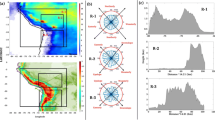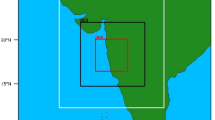Abstract
Climatic changes and the recent surge in weather extremities are alarming concerns for society today. Tropical squall events with extremely heavy rainfall and lightning are among the very severe ones among such activities. Usually, squalls have a leading convective edge followed by a stratiform trail; however, the reverse is also observed in rare cases. This work presented a thorough study on a conventional and an unconventional squall with nearly similar severities from a tropical location, Kolkata. The study reports notably high wind gusts and lightning activities during both events, with the latter one showing higher values. The CAPE increase and OLR drops were significant in both the cases. Breakage of storm front were noticed in the first squall, which possibly resulted in higher CAPE surrounding the study location even though the localised value was slightly larger during the second event. The unconventional squall having a shorter life cycle showed weaker vertical wind shear. The cloud system during the second squall structure showed dominance of smaller cloud particles and lower cloud top pressure than the first event, whereas the cloud mask fraction and cloud water path were large in this case. The rain microphysics has been studied for the two said events and a greater number of drops has been observed in the reflectivity through region than in the stratiform phase for the squall with trailing convective line, unlike the one with conventional structure. The rain microphysical properties showed clearly distinguishable behaviour during the three phases of the squall passage for both the events. Exceptionally high a values in empirical relation between Z and R were noticed in both the cases. The study reports higher path attenuation during the first event. The study can be useful in improving the understanding of the efficiency of different atmospheric and precipitation microphysical features in the predictability of a mesoscale system.
Research highlights
-
(1)
The current work has presented a thorough analysis of two tropical squalls with different organisational modes.
-
(2)
The variation in associated weather variables has been studied for the two events.
-
(3)
A thorough study of precipitation microphysics has been carried out for the two squalls.
-
(4)
The conventional factors used for prediction of mesoscale systems were analysed in detail for these cases to understand the efficiency of these elements in prediction of an unconventional convective system like a squall with a leading stratiform edge studied here.
























Similar content being viewed by others
References
Altaratz O, Koren I, Yair Y and Price C 2010 Lightning response to smoke from Amazonian fires; Geophys. Res. Lett. 37(7).
Betts A K 1976 The thermodynamic transformation of tropical sub-cloud layer by precipitation and downdrafts; J. Atmos. Sci. 30 1008–1020.
Betz H, Price C and Di Paola F 2013 Using a cloud electrification model to study relationships between Atmospheric lightning activity and cloud microphysical structure; Nat. Hazards Earth Syst. Sci. 13 1085–1104.
Buiat M, Porcu F and Dietrich S 2017 Observing relationships between lightning and cloud profiles by means of a satellite-borne cloud radar; Atmos. Meas. Tech. 10 221–230.
Carvalho K S and Wang S 2019 Characterising the Indian Ocean sea level changes and potential coastal flooding impacts under global warming; J. Hydrol. 569 373–386.
Chatterjee C and Das S 2020 On the association between lightning and precipitation microphysics; J. Atmos. Sol.-Terr. Phys. 207(105350), https://doi.org/10.1016/j.jastp.2020.105350.
Chaudhari H S, Sawaisarje G K and Ranalkar M R 2010 Thunderstorms over a tropical Indian station, Minicoy: Role of vertical wind shear; J. Earth Syst. Sci. 119 603–615.
Dalal S, Lohar D, Sarkar S, Sadhukhan I and Debnath G 2012 Organisational modes of squall-type mesoscale convective systems during pre-monsoon season over eastern India; Atmos. Res. 106 120–138.
Das S, Maitra A and Shukla A 2010 Rain attenuation modeling in the 10–100 GHz frequency using drop size distributions for different climatic zones in tropical India; Progr. Electromag. Res. 25 211–224.
De U, Dube R and Prakasa G 2005 Extreme weather events over India in the last 100 years; J. Ind. Geophys. Union 9 173–187.
Hamilton R A and Arch-bold J W 1945 Meteorology of Nigeria and adjacent territory; Quart. J. Roy. Meteorol. Soc. 71 231–264.
Huschke R E 1959 Glossary of meteorology; Boston American Meteorological Society.
Ippolito L J 1986 Radio wave propagation in satellite communication; Van Nostrand Reinhold Company, New York.
Johns R H and Doswell C A 1992 Severe local storms forecasting; Wea. Forecast 7 588–612.
Kozu T and Nakamura K 1991 Rainfall parameter estimation from dual-radar measurements combining reflectivity profile and path-integrated attenuation; J. Atmos. Ocean. Technol. 8(2) 259–270.
Lay E, Holzworth R, Rodger C, Thomas J, Pinto J and Dowden R 2004 WWLL global lightning detection system: Regional validation study in Brazil; Geophys. Res. Lett. 31.
Liebmann B and Smith C A 1996 Description of a complete (interpolated) outgoing longwave radiation dataset; Bull. Am. Meteorol. Soc. 77 1275–1277.
Makela A 2004 Comparison between lightning data and cloud top temperatures in Finland; EUMETSAT Conference Proceeding.
Marwitz J D 1972 The structure and motion of severe hailstorms. Part III: Severely sheared storms; J. Appl. Meteorol. Climatol. 11(1) 189–201.
Midyas S, Pal S, Dutta R, Gole P, Chattopadhyay G, Karmakar S, Saha U and Hazra S 2021 A preliminary study on pre-monsoon summer thunderstorms using ground-based total lightning data over Gangetic West Bengal; Ind. J. Phys. 95(1), https://doi.org/10.1007/s12648-020-01681-y.
Mishra A K, Nagaraju V, Rafiq M and Chandra S 2018 Evidence of links between regional climate change and precipitation extremes over India; Weather 99.
Molinie G and Jacobson A R 2004 Cloud-to-ground lightning and cloud top brightness temperature over the contiguous United States; J. Geophys. Res. 109(D13106) 1–16.
Moussa A, Diop B, Wade M, Abdoulaye S, Abdoulaye D, Aichetou D, Sarr D and Abdou F 2019 Case study of squall lines passing over Dakar using NOAA sounders; Int. J. Sci. Res. 8 272–276.
Mukhopadhyay P, Mahakur M and Singh H A K 2009 The interaction of large scale and mesoscale environment leading to formation of intense thunderstorms over Kolkata. Part I: Doppler radar and satellite observations; J. Earth Syst. Sci. 118 441, https://doi.org/10.1007/s12040-009-0046-1.
Nakazawa T 2006 Madden–Julian oscillation activity and typhoon landfall on Japan in 2004; SOLA 2 136–139.
Nayak H P and Mandal M 2014 Analysis of stability parameters in relation to precipitation associated with pre-monsoon thunderstorms over Kolkata, India; J. Earth Syst. Sci. 123 689–703.
Ochou A, Zahiri E, Bamba B and Koffi M 2011 Understanding the variability of Z–R relationships caused by natural variations in raindrop size distributions (DSD): Implication of drop size and number; Atmos. Clim. Sci. 1(3) 147–164.
Özdemir E, Yavuz V, Deniz A, Karan H, Kartal M, Kent S 2019 Squall line over Antalya: A case study of the events of 25 October 2014; Weather 74.
Parker M and Johnson R H 2000 Organizational modes of mid-latitude mesoscale convective systems; Month. Wea. Rev. 128(10) 3413–3436.
Platnick S, P Hubanks, K Meyer and King M D 2015 MODIS Atmosphere L3 Monthly Product (08_L3) NASA MODIS; Adaptive Processing System, Goddard Space Flight Center.
Pucik T, Groenemeijer P and Tsonevsky I 2021 Vertical wind shear and convective storms; ECMWF, https://doi.org/10.21957/z0b3t5mrv.
Rotunno R, Klemp J B and Weisman M L 1988 A theory for strong, long-lived squall lines; J. Atmos. Sci. 45(3) 463–485.
Saylor J R, Ulbrich C W, Ballentine J W and Lapp J L 2005 The correlation between lightning and DSD parameters; IEEE Trans. Geosci. Remote Sens. 43(8) 1806–1815.
Schiro K, Neelin J, Adams D and Lintner B 2016 Deep convection and column water vapor over tropical land vs. Tropical Ocean: A comparison between the Amazon and the Tropical Western Pacific; J. Atmos. Sci. 73.
Singleton A and Toumi R 2013 Super-Clausius–Clapeyron scaling of rainfall in a model squall line; Quart. J. Roy. Meteorol. Soc. 139 334–339.
Solomon R, Medaglia C, Adamo C, Dietrich S and Mugnai A 2003 Relating cloud microphysical properties and lightning: Model analysis of an extreme hailstorm; Proc. 5th EGS Plinius Conference, France.
Timothy K, Ong J and Choo E 2002 Raindrop Size Distribution Using Method of Moments for Terrestrial and Satellite Communication Applications in Singapore; IEEE Trans. Ant. Propagation 50(10).
Tokay A and Short D A 1996 Evidence from tropical raindrop spectra of the origin of rain from stratiform versus convective clouds; J. Appl. Meteor. 35 355–371.
Vidyarthi A, Jassal B S, Ieee R G M and Shukla A 2011 Comparison between empirical lognormal and gamma rain drop-size distribution models for Indian Region; Proc. Asia-Pacific Microwave Conference, pp. 1686–1689.
Wang Z, Lin L and Zhang X et al. 2017 Scenario dependence of future changes in climate extremes under 1.5°C and 2°C global warming; Sci. Rep. 7, https://doi.org/10.1038/srep46432.
Zhao B, Jiang J H, Gu Y, Diner D, Worden J, Liou K N, Su H, Xing J, Garay M and Huang L 2017 Decadal-scale trends in regional aerosol particle properties and their linkage to emission changes; Environ. Res. Lett. 12, https://doi.org/10.1088/1748-9326/aa6cb2.
Zipser E J 1969 The role of organised unsaturated convective downdrafts in the structure and rapid decay of an equatorial disturbance; J. Appl. Meteorol. 8(5) 799–814.
Zipser E J 1977 Mesoscale and convective-scale downdrafts as distinct components of squall-line structure; Mon. Wea. Rev. 105(12) 1568–1589.
Acknowledgements
The authors wish to thank the World Wide Lightning Location Network (http://wwlln.net), a collaboration among over 50 universities and institutions, for providing the lightning data used in this paper. The authors also thankfully acknowledge the official website of ISRO and ECMWF for providing access to the datasets used.
Author information
Authors and Affiliations
Contributions
Both authors contributed to the study and have read and approved the final manuscript.
Corresponding author
Additional information
Communicated by Parthasarathi Mukhopadhyay
Rights and permissions
About this article
Cite this article
Chatterjee, C., Das, S. Characteristic differences between two contrasting tropical squalls. J Earth Syst Sci 132, 58 (2023). https://doi.org/10.1007/s12040-023-02064-7
Received:
Revised:
Accepted:
Published:
DOI: https://doi.org/10.1007/s12040-023-02064-7




